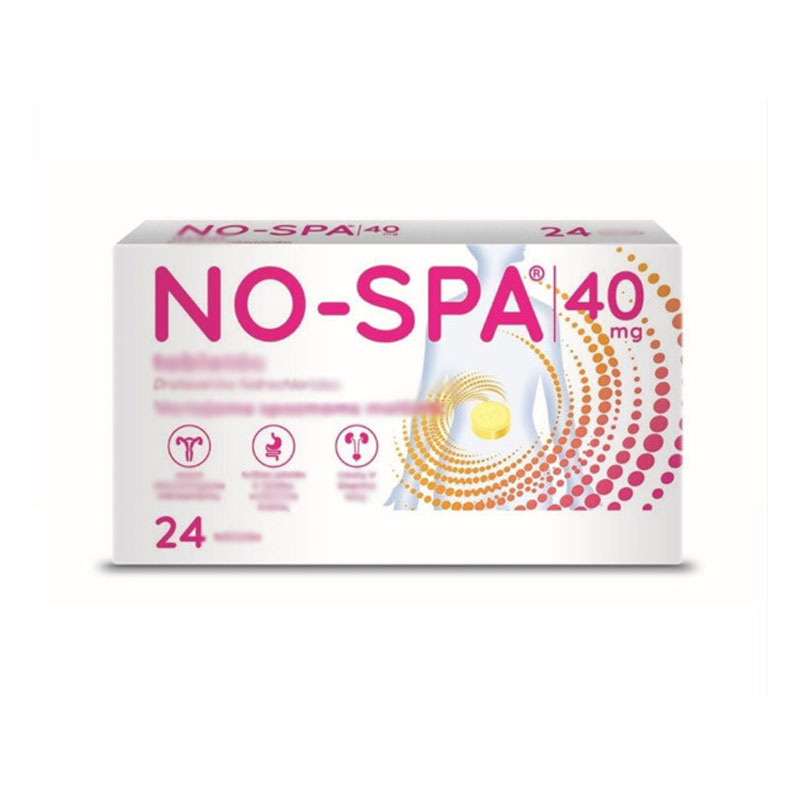NO-SPA Drotaverine Tablets 40 mg, N24
- Active Ingredient: Drotaverine Hydrochloride
-
$14.00
- Availability: In Stock
NO-SPA Drotaverine Tablets provide fast relief from smooth muscle spasms caused by gastrointestinal, biliary, and urinary conditions. Effective for colic, cramps, and menstrual pain. Safe for adults and children.
NO-SPA Drotaverine Tablets contain Drotaverine Hydrochloride, an antispasmodic medication that effectively relieves pain and discomfort caused by smooth muscle spasms. As an isoquinoline derivative, Drotaverine works by inhibiting the enzyme phosphodiesterase 4 (PDE4), which leads to smooth muscle relaxation. This results in effective relief from conditions associated with gastrointestinal, biliary, and urinary tract spasms, as well as gynecological and musculoskeletal discomfort.
Drotaverine’s effect is limited to smooth muscle, particularly in the gastrointestinal, biliary, urinary, and circulatory systems, without impacting cardiovascular function, making it a safer alternative for many patients. Drotaverine also improves blood flow to tissues due to its vasodilator action, benefiting patients with poor circulation.
Intended Use:
- Biliary tract diseases: Cholelithiasis (gallstones), cholecystitis, pericholecystitis, cholangitis, papillitis.
- Urinary system spasms: Urolithiasis (kidney stones), pyelitis, cystitis, and bladder tenesmus (painful urge to urinate).
- Gastrointestinal spasms: Spasms related to stomach ulcers, duodenal ulcers, gastritis, enteritis, colitis, and conditions associated with constipation and flatulence.
- Period pain: Alleviates pain from dysmenorrhea (painful menstruation).
Usage & Dosage:
- Adults: The recommended daily dose for oral administration is 120-240 mg (2-3 tablets) in divided doses. For acute colic (kidney or biliary), an intravenous (IV) dose of 40-80 mg may be administered.
- Children (1-6 years): Adjusted dosage of 40-120 mg in divided doses (2-3 hours apart).
- Children over 6 years: 80-200 mg per day in divided doses (2-5 administrations).
- Intramuscular (IM) or Intravenous (IV) Administration: For severe symptoms, 40-240 mg (divided into 1-3 injections per day) may be administered. For shortening cervical dilatation during labor, 40 mg IV or IM may be given and repeated if necessary after 2 hours.
Common Side Effects: mild nausea, constipation, and headache. In rare cases: dizziness, insomnia, palpitations, and hypotension. Severe allergic reactions (including anaphylaxis and bronchospasm) may occur in sensitive individuals, particularly with intravenous use.
Pregnancy & Lactation. While Drotaverine is not teratogenic or embryotoxic, its use during pregnancy should be considered only when the benefits outweigh the risks. Due to the lack of sufficient data, Drotaverine is not recommended during breastfeeding.
Overdose. No reported cases of overdose with NO-SPA Drotaverine. However, it is essential to follow prescribed dosages to avoid any adverse effects.
NO-SPA Drotaverine Tablets are an effective and safe option for relieving smooth muscle spasms, whether caused by gastrointestinal, biliary, or urinary tract conditions. The carefully selected PDE4 inhibition mechanism ensures targeted relief without affecting the cardiovascular system, making it a preferred choice for many patients.

